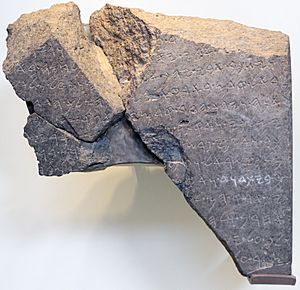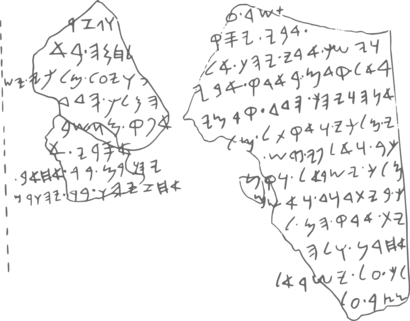Tel Dan stele facts for kids
Quick facts for kids Tel Dan Stele |
|
|---|---|

|
|
| Material | Basalt |
| Writing | Old Aramaic (Phoenician alphabet) |
| Created | 870–750 BCE |
| Discovered | 1993–94 |
| Present location | Israel Museum |
The Tel Dan Stele is a fragmentary stele containing an Aramaic inscription which dates to the 9th century BCE. It is the earliest known extra-biblical archaeological reference to the house of David.
The Tel Dan Stele was discovered in 1993 in Tel-Dan by Gila Cook, a member of an archaeological team led by Avraham Biran. Its pieces were used to construct an ancient stone wall that survived into modern times. The stele contains several lines of ancient Hebrew. The surviving inscription details that an individual killed Jehoram, King of Israel-Samaria, the son of Ahab, and Ahaziah of Judah, a king of the House of David. The stele is currently on display at the Israel Museum, and is known as KAI 310.
These writings corroborate passages from the Hebrew Bible, as the Second Book of Kings mentions that Jehoram is the son of an Israelite king, Ahab, by his Phoenician wife Jezebel. The likely candidate for having erected the stele, according to the Hebrew Bible, is Hazael, king of Aram-Damascus, whose language would have been Old Aramaic. He is mentioned in 2 Kings 12:17-18 as having conquered Israel-Samaria but not Jerusalem:
At that time, King Hazael of Aram came up and attacked Gath and captured it; and Hazael proceeded to march on Jerusalem. Thereupon King Joash of Judah took all the objects that had been consecrated by his predecessors, Kings Jehoshaphat, Jehoram, and Ahaziah of Judah, and by himself, and all the gold that there was in the treasuries of the Temple of GOD and in the royal palace, and he sent them to King Hazael of Aram, who then turned back from his march on Jerusalem.
Contents
Discovery and description
Fragment A of the stele was discovered in July 1993 by Gila Cook of Biran's team who was studying Tel Dan in northern Israel. Fragments B1 and B2 were found in June 1994. The stele was not excavated in its "primary context", but in its "secondary use".
The fragments were published by Biran and his colleague Joseph Naveh in 1993 and 1995.
Overview
The Tel Dan stele consists of several fragments making up part of a triumphal inscription in Old Aramaic, left most probably by Hazael of Aram-Damascus, an important regional figure in the late 9th century BCE. The unnamed king boasts of his victories over the king of Israel and his apparent ally the king of the "House of David" (Imperial Aramaic: 𐤁𐤉𐤕𐤃𐤅𐤃, romanized: bytdwd). It is considered the earliest widely accepted reference to the name David as the founder of a Judahite polity outside of the Hebrew Bible, though the earlier Mesha Stele contains several possible references with varying acceptance. A minority of scholars have disputed the reference to David, due to the lack of a word divider between byt and dwd, and other translations have been proposed. The Tel Dan stele is one of only four known extra-biblical inscriptions made during a roughly 400-year period (1200–800 BCE) containing the name "Israel", the others being the Merneptah Stele, the Mesha Stele, and the Kurkh Monoliths.
The Tel Dan inscription generated considerable debate and a flurry of articles, debating its age, authorship, and authenticity; however, the stele is generally accepted by scholars as genuine and a reference to the House of David.
Text
The following is the transcription. Dots separate words (as in the original), empty square brackets indicate damaged/missing text, and text inside square brackets is reconstructed by Biran and Naveh:
1. [ 𐤀]𐤌𐤓.𐤏[ ]𐤅𐤂𐤆𐤓[ ]
2. [ ---].𐤀𐤁𐤉.𐤉𐤎𐤒[.𐤏𐤋𐤅𐤄.𐤁𐤄]𐤕𐤋𐤇𐤌𐤄.𐤁𐤀[ ]
3. 𐤅𐤉𐤔𐤊𐤁.𐤀𐤁𐤉.𐤉𐤄𐤊.𐤀𐤋[.𐤀𐤁𐤄𐤅]𐤄.𐤅𐤉𐤏𐤋.𐤌𐤋𐤊𐤉[ 𐤉𐤔]
4. 𐤓𐤀𐤋.𐤒𐤃𐤌.𐤁𐤀𐤓𐤒.𐤀𐤁𐤉[.𐤅]𐤄𐤌𐤋𐤊.𐤄𐤃𐤃[.]𐤀[𐤉𐤕𐤉]
5. 𐤀𐤍𐤄.𐤅𐤉𐤄𐤊.𐤄𐤃𐤃.𐤒𐤃𐤌𐤉[.𐤅]𐤀𐤐𐤒.𐤌𐤍.𐤔𐤁𐤏[𐤕---]
6. 𐤉.𐤌𐤋𐤊𐤉.𐤅𐤀𐤒𐤕𐤋.𐤌𐤋[𐤊𐤍.𐤔𐤁]𐤏𐤍.𐤀𐤎𐤓𐤉.𐤀[𐤋𐤐𐤉.𐤓]
7. 𐤊𐤁.𐤅𐤀𐤋𐤐𐤉.𐤐𐤓𐤔.[𐤒𐤕𐤋𐤕.𐤀𐤉𐤕.𐤉𐤄𐤅]𐤓𐤌.𐤁𐤓.[𐤀𐤇𐤀𐤁.]
8. 𐤌𐤋𐤊.𐤉𐤔𐤓𐤀𐤋.𐤅𐤒𐤕𐤋[𐤕.𐤀𐤉𐤕.𐤀𐤇𐤆]𐤉𐤄𐤅.𐤁𐤓[.𐤉𐤄𐤅𐤓𐤌.𐤌𐤋]
9. 𐤊.𐤁𐤉𐤕𐤃𐤅𐤃.𐤅𐤀𐤔𐤌.[𐤀𐤉𐤕.𐤒𐤓𐤉𐤕.𐤄𐤌.𐤇𐤓𐤁𐤕.𐤅𐤀𐤄𐤐𐤊.𐤀]
10. 𐤉𐤕.𐤀𐤓𐤒.𐤄𐤌.𐤋[𐤉𐤔𐤌𐤍 ]
11. 𐤀𐤇𐤓𐤍.𐤅𐤋𐤄[... 𐤅𐤉𐤄𐤅𐤀.𐤌]
12. 𐤋𐤊.𐤏𐤋.𐤉𐤔[𐤓𐤀𐤋... 𐤅𐤀𐤔𐤌.]
13. 𐤌𐤑𐤓.𐤏[𐤋. ]
Romanized:
- [ ʾ]mr.ʿ[ ]wgzr[ ]
- [ ---].ʾby.ysq[.ʿlwh.bh]tlḥmh.bʾ[ ]
- wyškb.ʾby.yhk.ʾl[.ʾbhw]h.wyʿl.mlky[ yś]
- rʾl.qdm.bʾrq.ʾby[.w]hmlk.hdd[.]ʾ[yty]
- ʾnh.wyhk.hdd.qdmy[.w]ʾpq.mn.šbʿ[t---]
- y.mlky.wʾqtl.ml[kn.šb]ʿn.ʾsry.ʾ[lpy.r]
- kb.wʾlpy.prš.[qtlt.ʾyt.yhw]rm.br.[ʾḥʾb.]
- mlk.yśrʾl.wqtl[t.ʾyt.ʾḥz]yhw.br[.yhwrm.ml]
- k.bytdwd.wʾšm.[ʾyt.qryt.hm.ḥrbt.wʾhpk.ʾ]
- yt.ʾrq.hm.l[yšmn ]
- ʾḥrn.wlh[... wyhwʾ.m]
- lk.ʿl.yś[rʾl... wʾšm.]
- mṣr.ʿ[l. ]
The 1995 translation by Biran reads;
- [ ]...[...] and cut [...]
- [...] my father went up [against him when h]e fought at [...]
- and my father lay down, he went to his [ancestors (viz. became sick and died)]. And the king of I[s-]
- rael entered previously in my father's land, [and] Hadad made me king,
- And Hadad went in front of me, [and] I departed from the seven [...-]
- s of my kingdom, and I slew [seve]nty kin[gs], who harnessed th[ousands of cha-]
- riots and thousands of horsemen (or: horses). [I killed Jeho]ram son [of Ahab]
- king of Israel, and [I] killed [Ahaz]iahu son of [Jehoram kin-]
- g of the House of David, and I set [their towns into ruins and turned ]
- their land into [desolation ]
- other [... and Jehu ru-]
- led over Is[rael and I laid]
- siege upon [ ]
Other scholars have presented alternate translations. For example, Andre Lemaire's 1998 translation reads;
- [.....]..[.............] and cut [..............]
- [.....] my father went up [......f]ighting at/against Ab[...]
- And my father lay down, he went to his [fathers]. And the kings of I[s-]
- rael penetrated into my father's land[. And] Hadad made me - myself - king
- And Hadad went in front of me[, and] I departed from .... [....]
- of my kings. And I killed two power[ful] kin[gs], who harnessed two thou[sand cha-]
- riots and two thousand horsemen. [I killed Jo]ram son of [Ahab]
- king of Israel, and I killed [Achaz]yahu son of [Joram king]
- of the House of David. And I set [......]
- their land [.......]
- other ...[............ and Jehu ru-]
- led over Is[rael ............]
- siege upon [.......]
The main differences are on line 6 and 7; Lemaire suggests that two kings, rather than seventy, were killed and that they possessed two thousand chariots and horsemen.
Content
In the second half of the 9th century BCE (the most widely accepted date for the stele), the kingdom of Aram-Damascus, under its ruler Hazael, was a major power in the Levant. Dan, just 70 miles from Hazael's capital of Damascus, would almost certainly have come under its sway. This is borne out by the archaeological evidence: Israelite remains do not appear until the 8th century BCE, and it appears that Dan was already in the orbit of Damascus even before Hazael became king in c. 843 BCE.
The author of the inscription mentions conflict with the kings of Israel and the 'House of David'. The names of the two enemy kings are only partially legible. Biran and Naveh reconstructed them as Joram, son of Ahab, King of Israel, and Ahaziah, son of Joram of the House of David. Scholars seem to be evenly divided on these identifications. It is dependent on a particular arrangement of the fragments, and not all scholars agree on this.
In the reconstructed text, the author tells how Israel had invaded his country in his father's day, and how the god Hadad then made him king and marched with him against Israel. The author then reports that he defeated seventy kings with thousands of chariots and horses (more on this below). In the very last line there is a suggestion of a siege, possibly of Samaria, the capital of the kings of Israel. This reading is, however, disputed.
See also
- Historicity of David
- List of artifacts significant to the Bible


